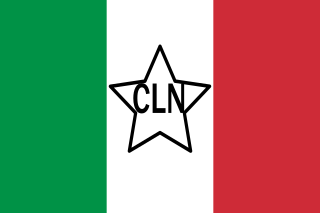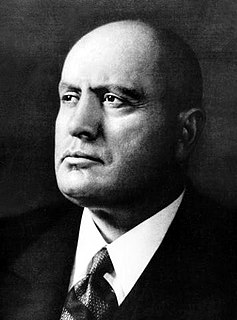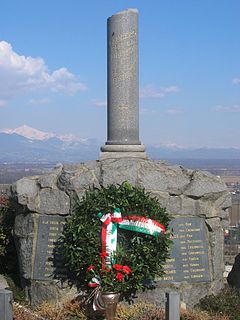
The Italian resistance movement is an umbrella term for the Italian resistance groups who fought the occupying forces of Nazi Germany and the fascist collaborationists of the Italian Social Republic during the final phase of the Second World War in Italy from 1943 to 1945. As an anti-fascist movement and organisation, La Resistenza opposed Nazi Germany, as well as Nazi Germany's Italian puppet state regime, the Italian Social Republic, which was created by the Germans following the Nazi German invasion and military occupation of Italy by the Wehrmacht and the Waffen-SS from September 1943 until April 1945.

Alberto Moravia was an Italian novelist and journalist. His novels explored matters of modern sexuality, social alienation and existentialism. Moravia is best known for his debut novel Gli indifferenti (1929) and for the anti-fascist novel Il Conformista, the basis for the film The Conformist (1970) directed by Bernardo Bertolucci. Other novels of his adapted for the cinema are Agostino, filmed with the same title by Mauro Bolognini in 1962; Il disprezzo, filmed by Jean-Luc Godard as Le Mépris ; La Noia (Boredom), filmed with that title by Damiano Damiani in 1963 and released in the US as The Empty Canvas in 1964 and La ciociara, filmed by Vittorio De Sica as Two Women (1960). Cédric Kahn's L'Ennui (1998) is another version of La Noia.

Lelio Basso was an Italian democratic socialist politician, political scientist and journalist.
The Aventine Secession was the withdrawal of the parliament opposition, mainly comprising the Italian Socialist Party, Italian Liberal Party, Italian People's Party and Italian Communist Party, from the Italian Chamber of Deputies in 1924–25, following the murder of the deputy Giacomo Matteotti by fascists on June 10th, 1924.

Filippo Turati was an Italian sociologist, criminologist, poet and socialist politician.

Giustizia e Libertà was an Italian anti-fascist resistance movement, active from 1929 to 1945. The movement was cofounded by Carlo Rosselli, Ferruccio Parri, who later became Prime Minister of Italy, and Sandro Pertini, who became President of Italy, were among the movement's leaders.

The Italian Civil War was a civil war in the Kingdom of Italy fought during World War II from 8 September 1943 to 2 May 1945, by the Italian Fascists of the Italian Social Republic, a collaborationist puppet state created under the direction of Nazi Germany during its occupation of Italy, against the Italian partisans, materially supported by the Allies, in the context of the Italian campaign. The Italian partisans and the Italian Co-Belligerent Army of the Kingdom of Italy simultaneously fought against the occupying Nazi German armed forces. Armed clashes between the National Republican Army of the Italian Social Republic and the Italian Co-Belligerent Army of the Kingdom of Italy were rare, while there was some internal conflict within the partisan movement. In this context, Germans, sometimes helped by Italian Fascists, committed several atrocities against Italian civilians and troops.

The Years of Lead is a term used for a period of social and political turmoil in Italy that lasted from the late 1960s until the late 1980s, marked by a wave of both far-left and far-right incidents of political terrorism.

Corrado Alvaro was an Italian journalist and writer of novels, short stories, screenplays and plays. He often used the verismo style to describe the hopeless poverty in his native Calabria. His first success was Gente in Aspromonte, which examined the exploitation of rural peasants by greedy landowners in Calabria, and is considered by many critics to be his masterpiece.
The Acca Larentia massacre was the journalistic name given to a double homicide that occurred in Rome on 7 January 1978. Five teenagers of the youth wing of the Italian Social Movement were ambushed while leaving the local party headquarters, and two of the teens were killed. The killings caused riots that same day, in which another MSI sympathiser was killed in clashes with police.
Secolo d'Italia is a daily, conservative, online newspaper in Italy, published since 1952. In 2012, it ceased its print edition and continued as an online-only publication.

Giovanni Host-Venturi, also known as "Nino" Host-Venturi was an Italian fascist politician and historian.
Costantino Bresciani Turroni was an Italian economist and statistician.
Pier Antonio Quarantotti Gambini was an Italian writer and journalist, author of novels, poetry, and essays.
The Democratic Fascist Party was a clandestine Italian fascist political party.

The death of Benito Mussolini, the deposed Italian fascist dictator, occurred on 28 April 1945, in the final days of World War II in Europe, when he was summarily executed by an Italian partisan in the small village of Giulino di Mezzegra in northern Italy. The generally accepted version of events is that Mussolini was shot by Walter Audisio, a communist partisan. However, since the end of the war, the circumstances of Mussolini's death, and the identity of his executioner, have been subjects of continuing dispute and controversy in Italy.

The Massacre of Salussola consists in the execution, preceded by torture, of 20 Italian Partisans, committed in retaliation by Italian Fascist soldiers on March 9, 1945 in the town of Salussola (Italy).

Giorgio Pisanò was an Italian journalist, essayist and neo-fascist politician.

The Brigate Garibaldi or Garibaldi Brigades were partisan units aligned with the Italian Communist Party active in the armed resistance against both German and Italian fascist forces during World War II.

The Red Republic of Caulonia was a short lived revolutionary communist Italian state formed on 6 March 1945 by the mayor of Caulonia Pasquale Cavallaro, an elementary teacher and former seminarian who joined the Italian Communist Party in 1943.













